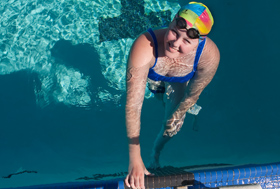Teen with spina bifida benefits from advanced hip surgery at Rady Children’s
By Josh Baxt

Sixteen-year-old Samantha is an accomplished Paralympics swimmer.
Amanda Geier doesn’t smile when she recounts the medical advice she once received about her daughter Samantha’s spina bifida. “I was told that what’s going to happen is going to happen, and there’s no point in trying to prevent anything,” she said.
For the Geier family, that simply wasn’t good enough. “You learn to fight for your kid to be able to do the things she wants to do,” Amanda said.
Spina bifida is a congenital condition in which the spinal cord, or the vertebrae which surround it, do not completely form, damaging nerves and causing muscle weakness. Samantha had her first surgery at Rady Children’s Hospital-San Diego when she was 6 weeks old. The procedure allowed her spinal cord to move normally, rather than being tethered at its base. Now 16, Samantha has had several procedures since.
The condition presents many obstacles, and Samantha has learned to overcome them one by one. It hasn’t been easy.
Early on, Samantha was relatively untroubled by the disease. But as she grew, scar tissue on her spinal cord forced a second surgery, after which she lost muscle function. She had to give up some activities, such as dance and soccer.
Undeterred, Samantha started swimming, an ideal exercise because it’s not weight-bearing.
She went on to compete, excelling at the longer distance freestyle and backstroke events and participating in the Paralympics.
But spina bifida interfered once again, as her hip began popping out of its socket, causing intense pain. Her hip muscles were just too weak to hold the joint in place. When swimming, Samantha’s flip turns would sometimes pop the hip, but otherwise the condition was unpredictable.
“I didn’t know when it would happen,” said Samantha. “It could happen in bed.”
The only answer was more surgery. Harish Hosalkar, M.D., a pediatric orthopedic surgeon who also directs the Hip Research Center at Rady Children’s, stepped in to fix the problem, performing a challenging muscle transfer procedure.
For the Geiers, Dr. Hosalkar was the ideal surgeon, approaching Samantha’s treatment with the same mixture of optimism and straight talk the family has come to appreciate. “He’s realistic,” Amanda said. “He tells you what can and cannot happen. He explains there’s no guarantee.”
“We all understood it was a difficult procedure,” Dr. Hosalkar said. “But I told them, if nothing else, I could stop the pain.”
The surgery was done in summer 2011. Since then, Samantha’s hip hasn’t popped out once, and she’s no longer in pain. She’s back in the pool and hopes to compete again in the future.
“The surgery has given back her ability to swim,” said Amanda. “It’s one of the few aerobic exercises that is readily available and that she can do to stay healthy for a lifetime. It’s wonderful that she has that option.”
Having overcome this most recent obstacle, Samantha has other tasks to occupy her. She is an excellent student, sings in the choir and tutors others. For her, spina bifida is now mostly an inconvenience.
“I need to plan ahead and allow more time to get things done,” Samantha said. “I have to factor in time to put on my leg braces and check out wheelchair access. I try to figure out the fastest, most productive way to get where I want to be.”
One of the places she wants to be is college. Though moving away from home will present a new set of challenges, Samantha is looking forward to the adventure. Spina bifida will just have to get out of the way.
Originally published in U-T San Diego, October 2012